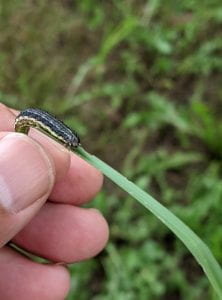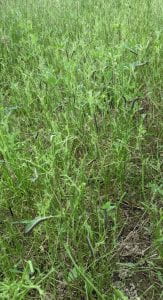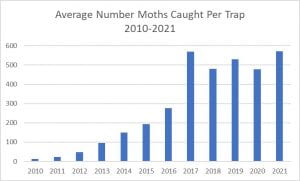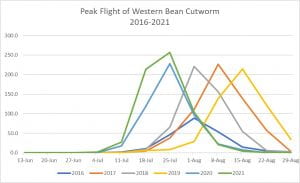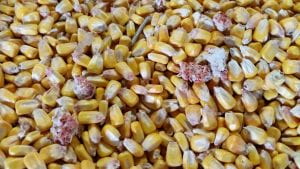NYS IPM Weekly Field Crops Pest Report
Fall Armyworm Alert
This week near Kinderhook in Eastern NY there is a large infestation of fall armyworm larvae in a 50-acre alfalfa field. The larvae completely ate all of the alfalfa leaflets leaving only the stems on the 50 acres. They were in the 2nd to 3rd instar of development. This means they are still small. Fall armyworms normally go through 6 instars and will eat much more forage before they pupate. The range of the infestation was 5 to 15 larvae per square foot. Fall armyworm in other parts of the country has been causing issues this season. It would be best to go out and check your crops for fall armyworm. The threshold for fall armyworms in alfalfa is 1-3 larvae per square foot. Many of the Bt corn hybrids are resistant to fall armyworm. Fall armyworms will feed on many other types of grass. It is best to get out and scout fields now!
There will be more information on insecticides that can be used on field crops for fall armyworm coming this week!
Western bean cutworm
The western bean cutworm-trapping season has ended. There were not a lot of reports of fields over threshold this year for western bean cutworm. The average moths caught per trap for the season was 571. It seems like western bean cutworm may have leveled off statewide for average numbers of moths caught in traps for a season. This pest may have stabilized in NYS since it was found in 2009. Many growers now use the Viptera Hybrid that is resistant to western bean cutworm. This pest can do economic damage to grain corn but not silage corn.
The peak flight varies from year to year depending on the temperatures that accrue during the growing season. The last two years the peak flight has been the last week in July. It will be important to follow the peak flight if you are using a non-resistant hybrid. You can time your scouting next season with the rising number of moths flying.
Stored Grain Insect Pests
Have you prepared your stored grain bins to reduce pest infestations? Sealing holes, cleaning out old grain, cleaning under the floorboards and treating the inside of the bin is important. This will help keep the insect pests from entering the bin and damaging the grain. For more information: https://entomology.ca.uky.edu/ef145
Clipboard Checklist
Keith Waldron, NYS IPM
General
*Walk fields to check general field condition, weed, vertebrate and other issues
*Watch for crop maturity, stand assessments, weed escapes, nutrient deficiencies, lodging issues
Alfalfa:
*Evaluate established legume stands for approximate days until harvest
*Monitor potato leafhopper, foliar, systemic and crown rot diseases.
*Monitor new seedings for potato leafhopper, pythium blight, phytopthora root rot.
Small Grains:
*Monitor grain fields for growth stage, disease and lodging issues, grain maturity, harvest timing
*Record diseases present, location and types of weed escapes
Corn:
*Monitor for mid-season corn pests including European corn borer, corn rootworm, western bean cutworm, slugs, foliar diseases such as northern corn leaf blight and gray leaf spot, weed issues, nutrient deficiencies, vertebrate damage.
Soybeans:
*Monitor for soybean aphid, defoliators, foliar diseases, white mold, weed issues, vertebrate damage
Pastures:
*Check water sources, mend fences as needed.
*Check crop growth, clip pastures between grazing as needed
*Monitor for invasive species, plants harmful to livestock
*Review/Plan rotations
Storage:
* Check stored grain bins for temperature, moisture and signs of mold and insects. Aerate, core, transfer grain or treat as necessary
* Clean and disinfect empty storage bins in preparation for grain harvest
*Check forage allocation and anticipate feed program adjustments as forages from previous year are used up
*Mow around storage bins and facility to minimize pest hiding places
Dairy Cattle Barn Fly Management:
*Monitor animals and barn area for house fly, stable fly and other pest management needs including presence of rodents and birds.
*Check facilities for favorable fly breeding conditions: (organic matter + moisture): leaks in watering systems, roof gutters for leaks and potential overspill, drainage,
*Sanitation, sanitation, sanitation – clean animal resting areas, feed troughs, minimize source of moist organic matter i.e. fly breeding areas in barn and in adjacent animal loafing yard
* Continue fly monitoring: install “3X5″ index card fly speck monitoring cards throughout barn
*Use, replenish, replace fly management materials: sticky fly tapes/ribbons, insecticide baits, natural enemies (parasitoids), fly population monitoring (3 x 5) spot cards
*Consider purchase and release of Muscidifurax raptor and/or M. raptorellus natural enemies of house and stable fly pupae.
Dairy Cattle on Pasture:
*Monitor animals for presence of face flies, horn flies and stable flies. Action guidelines: face flies (average 10 per animal face), horn flies (average 50 / dairy per animal side, 200 / beef cattle per animal side), stable flies average 10 per animal (all four legs)
*Check feed bunk / water source locations for signs of stable fly breeding (moist undisturbed organic matter – spilled feed, round bales, etc.), minimize source of moist organic matter i.e. fly breeding areas in barn and in adjacent animal exercise yard.
*Check pasture for forage quality / quantity, rotate as appropriate
*Check pasture for vegetation poisonous to livestock
*Consider use of pasture fly traps to help reduce deer, horse and stable fly populations

